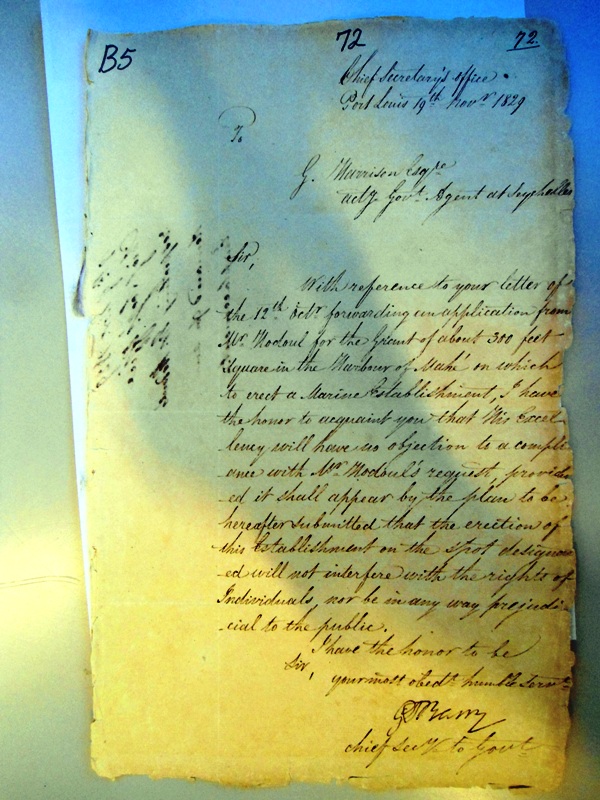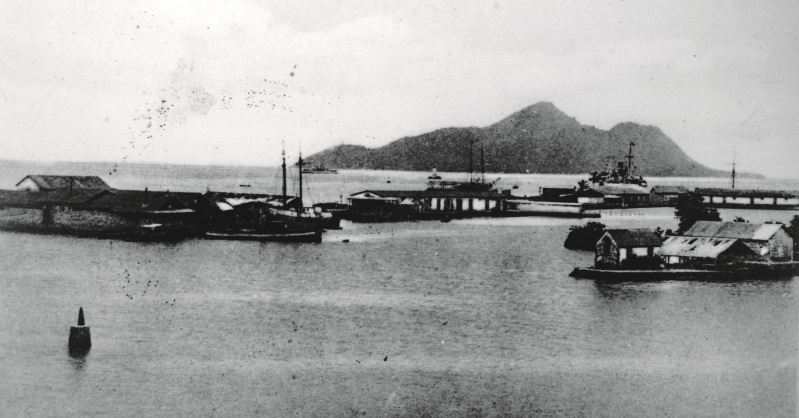Hodoul Island |02 May 2015

Few of us know the history of Hodoul Island, this small uninhabited islet that lies in the tidal basin of Victoria Harbour. On behalf of the Research Section of the National Heritage Institute, Tony Mathiot enlightens us with a few fascinating facts.
So, it is called Hodoul Island, this small, oval and flat land mass overgrown with casuarinas trees that lies some thirty breast strokes from the sea wall at the Seychelles Nation building at the entrance channel of the Marine Charter and the Yacht Club. Much smaller than Freedom Square, there is nothing particularly interesting about this ‘island’. In fact, it is bereft of all the features that characterise our inlying islands – coconut palms, a granite coastline – but a small cabin of coral limestone on its northern edge could arouse your curiosity and make you wonder. Moreover, you will find it baffling that Hodoul Island is not featured on old maps of Mahé, why?
Well, history can be so enervatingly enlightening.
In his letter of 28th July, 1873 to the Colonial Secretary of Mauritius, Chief Commissioner William Hales Franklyn (1816 – 1874) wrote of ‘... the so-called island Hodoul being only a wharf that has been constructed upon a submerged reef on the shore side of the inner harbour...’.
That is rightly so, because in his letter dated 19th November, 1829, the Governor of Mauritius Galbraith Lowly Cole (1772 – 1842) informed the Chief Commissioner of Seychelles George Harrison that Mr Hodoul had been given permission ‘for a grant of about 300 feet square in the harbour of Mahé on which to erect a marine establishment’.
‘Mr Hodoul’ was actually Jean François Hodoul (1765 – 1835) a French Corsair, who arrived in Seychelles in 1791 on his ship Les Deux Soeurs. He stayed for one year before returning to Ile de France (Mauritius). In 1794 he returned to Seychelles where, on the 9th June 1794, he married a fifteen year old Reunionaise girl named Marie Corantine Olivette Jorre de St. Jorre (1779 – 1856). After that, he roved the Indian Ocean attacking British vessels and confiscating their cargoes apparently with official sanction from Ile de France. By the time the British had taken official possession of the Seychelles in 1814, the Corsair had settled down at Chateau Mamelles with his wife and children. He owned a few properties on which he cultivated cacao plantations, and he had many boats.
Whatever imputations of moral turpitude that his reputation as a swash-buckling picaroon must have evoked among his fellow citizens, Hodoul must have impressed them with his resoluteness and steadfastness of purpose. To build a careenage in the inner harbour of Mahé at that time must certainly have been a grandiose scheme and a daunting task. But Hodoul had the wherewithals to achieve his ambitious project – he had brawny robust slaves and boats. So, for many months, the clusters of outcrops of rocks that Capt Corneille Nicholas Morphey (1724 – 1744) must have noticed and steered clear of on the 1st November of 1756 when he brought the Stone of Possession to Mahé, were filled in with rocks and debris. These were dumped, stuffed and crammed into the spaces to form a square of solid ground, a perfect careenage, an islet even. And it was there that Hodoul’s boats and many others were brought for careening purposes. During those days sailing vessels navigated by wind.
When Jean François Hodoul passed away on 16th January, 1835, his eldest son Barthelemy (1808 – 1853) took over the control of the ‘Marine Establishment’. According to stipulations in the Agreement Document that gave Hodoul permission to create his careenage, he was not to become owner but that a concession en jouissance would be granted to him.
In 1851 Hodoul’s widow Olivette made a request to Commissioner Robert William Keat (1814 – 1873) for her to have the continuation of the en jouissance concession which would also devolve to her daughter Marie Aimée when she died. Keat agreed ‘... but subject to the condition rights of the crown colony being specially reserved’.
Thus, the Corsair’s children had the privilege of ‘owning’ his eponymous marine establishment for many decades after his death, during which time, scores of boats must have undergone repairs there.
However, if during the Hodoul era, the careenage proved its vital importance by catering to the needs of many boat owners who had no other suitable place where they could have their boats repaired and cleaned, it was in the 1870s that Hodoul Island became a coveted site when coal became an indispensable and lucrative commodity. Since 1864, steamships of the messageries maritimes and those of the British India Steam Navigation company had been calling regularly at Port Victoria, and consequently it became an imperative necessity to supply these steamers with quantities of coal for fuel. One man who wanted to exploit its commercial potential was Dr. Henry Brooks (1831 – 1920) the Government Medical Officer. On the 4th May of 1872, he took a lease of Hodoul Island that would extend for 25 years at a rent rising from €5 by small periodical increments. But, soon after, his mercantile zeal to have a monopoly on the coal trade placed him at loggerheads with Commissioner Franklyn – because Brooks felt that he should be exempted from paying Quay Dues on the coal that was landed on Hodoul Island because the island had not been proclaimed a Legal Quay – an argument which Franklyn courteously refuted. Moreover, Brooks disapproved of the creation of other coal wharves for other companies.
placed him at loggerheads with Commissioner Franklyn – because Brooks felt that he should be exempted from paying Quay Dues on the coal that was landed on Hodoul Island because the island had not been proclaimed a Legal Quay – an argument which Franklyn courteously refuted. Moreover, Brooks disapproved of the creation of other coal wharves for other companies.
Franklyn, upon his arrival in 1868 had made it a priority on his agenda to create port facilities for Mahé, on account of the increasing trade and number of vessels using port. He initiated the construction of the Long Pier by extending the Mylius Wharf and the erection of the Victoria Lighthouse, and recommended that the application of Harbour Regulations and Quay dues were of an urgent necessity in order for Seychelles to earn some revenue from the increasing maritime traffic. Dr. Brooks who had entered into a contract with the Admiralty for the supply of coal to Her Majesty’s Ships calling at Seychelles was also the sole dealer in coral ballast. To maximise his profit in the coal trade
and number of vessels using port. He initiated the construction of the Long Pier by extending the Mylius Wharf and the erection of the Victoria Lighthouse, and recommended that the application of Harbour Regulations and Quay dues were of an urgent necessity in order for Seychelles to earn some revenue from the increasing maritime traffic. Dr. Brooks who had entered into a contract with the Admiralty for the supply of coal to Her Majesty’s Ships calling at Seychelles was also the sole dealer in coral ballast. To maximise his profit in the coal trade , Brooks established another coal depot on Ste. Anne islands. However, by 1879, he faced stiff competition from other coal traders including a French company named Roux de Frassinet and messrs of Marseilles whose agent was the French Consul Felix Desire Cheyron (1840 – 1896). Coal was imported from Cardiff, Wales and Ceylon. Quantities of charcoal burnt in the timber forests of Mahé were also supplied to the coal depots.
, Brooks established another coal depot on Ste. Anne islands. However, by 1879, he faced stiff competition from other coal traders including a French company named Roux de Frassinet and messrs of Marseilles whose agent was the French Consul Felix Desire Cheyron (1840 – 1896). Coal was imported from Cardiff, Wales and Ceylon. Quantities of charcoal burnt in the timber forests of Mahé were also supplied to the coal depots.
By the end of the First World War, when coal-burning ships where being replaced by diesel-engined ships, the market for coal petered out. Hodoul Island was then leased by a succession of commercial traders who amended and extended the island.
In 1906, the firm of Baty, Bergne & Co, a lighterage company which had been formed in 1899 had a lease of the island. In 1927, the Victoria Yacht Club applied for the lease to be transferred to it, but their request was not granted. However, the club was allowed to sub-lease the island in order to erect premises there since careenage facilities close to the harbour were then scarce, boat owners were allowed to have their fishing vessels repaired on the island. Boats were also moored alongside it.
In 1901, Governor Sweet Escott (1859 – 1941) had a boatshed built there at a cost of SR493.63 cents.
In the late 1960s, a first modern reclamation project gave Port Victoria many hectares of land for construction projects that included marine facilities. The island then became known as Hodoul Island Ammunition Depot. It was where the P.W.D (Public Works Department) kept dynamites and explosives in safe isolation.
In December of 1985, a massive reclamation project was undertaken to reclaim about 100 hectares of land along the east coast of Mahé. While it was deepening the Victoria yacht basin, the Belgian dredger Marco Polo added some 5,000 cubic metres of coral head to fill in the gap between Hodoul Island and a small portion of protruding reefs to create a larger Hodoul Island to prevent any damage from the high tide.
During the last thirty years, the island has remained virtually unoccupied, lying there in the tidal basin of the inner harbour, waiting to service the whims of our twenty-first century requirements. A maritime museum, maybe, or perhaps a small sea-food restaurant named Hirondelle after one of his many ships which was stolen in 1817 by an unscrupulous French captain as payment owed to him for twenty-two slaves by Jean Baptiste Queau de Quinssy (1748 – 1827), or Olivette, after his beloved wife who gave him nine daughters and three sons.
Nevertheless, it has all the merits of a national monument indeed, it reminds us of those days when our country was a naval coaling station and the rest of the world was far away. Above all, it is, well, partly the souvenir of an 18th century corsair who dared to make Seychelles his home.








